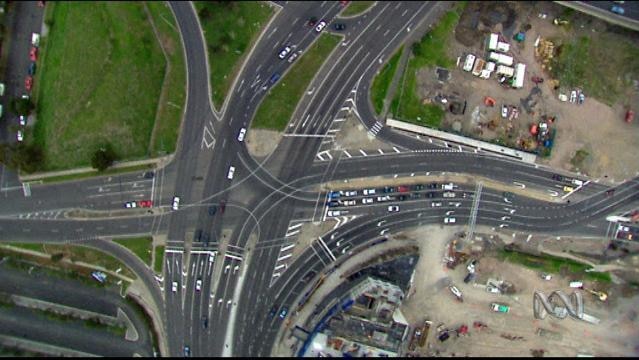Dr Maryanne Demasi in a street with a mobile phone
DR MARYANNE DEMAISI
My phone is transmitting a signal letting my phone company know where I am anytime, anywhere. And that goes for anyone with a mobile. But how can this information help to plan a city?
Professor Carlo Ratti — Architect/Engineer Massachusetts Inst. of Technology
PROFESSOR CARLO RATTI
It has been a longstanding effort in planning, to try and understand really how people move in the city, how cars and pedestrians move, there's a lot of traditional techniques. What you can do now is really see what's happening in real time.
DR MARYANNE DEMAISI
Professor Carlo Ratti is finding new ways of exploiting digital technology to design better cities.
PROFESSOR CARLO RATTI
What we're doing is we are taking data, that are bi-products of the cell phone network operations, and if you take those data and if you analyse it, then you can get really an interesting picture of the city. You can understand where there is a problem, congestion problem, you can understand where maybe there's a critical point on the urban infrastructure and if you take all these data, you analyse it, then you've got a wonderful base of information to design better cities.
DR MARYANNE DEMAISI
With the backing of Telecom Italia and the city's Mayor, Carlo used his high-tech methods to analyse the chaos and congestion of Rome.
PROFESSOR CARLO RATTI
So what we got was, well, the information from the cell phone network, and then all the information from all the buses in real time through GPS, all the taxis in real time through GPS, and when you actually merge this information, that becomes an extremely powerful way to visualise urban dynamics.
DR MARYANNE DEMAISI
Carlo showed that monitoring the cities' dynamics in real time provides invaluable information for urban planners. So what do you use it for?
PROFESSOR CARLO RATTI
Well, there's many possible applications, you know. The most obvious in a certain sense is traffic, you know, looking at congestion and buses and things.
DR MARYANNE DEMAISI
You can get information about road congestion from traffic cameras and road sensors, but using mobile phone data can map the movements of people — whether they're in their cars, on their bikes or just on foot. And obtaining this information is quite cheap given that mobile phone data is already collected by phone companies.
PROFESSOR CARLO RATTI
Think about the environmental benefits, there's billions spent every year just because of traffic jams and if you're able to address just a fraction of that by making the city more efficient, then that's a big advantage.
DR MARYANNE DEMAISI
Carlo also looked at the impact of big sporting events.
PROFESSOR CARLO RATTI
We looked at the city during the World Cup, the final, when Italy won the soccer World Cup.
DR MARYANNE DEMAISI
They were able to create a map which showed where masses of people celebrated Italy's win throughout the night and next day.
Dr Maryanne Demasi in a cafe
DR MARYANNE DEMAISI
The real vibe of a city comes from the interaction between people. Cities need places where people can come together, to encourage a real sense of community. So, it may not be long before you can access a real-time map to find the most crowded place to have a drink and the quickest way to get there. And that's not all. Advertisers could use this information to locate billboards in areas of high pedestrian activity. But will all this access to phone data raise privacy issues?
PROFESSOR CARLO RATTI
There's no privacy implications because of really the type of data we get. We're actually not seeing individual people, so we're seeing like density and statistical and anonymous and aggregated data.
DR MARYANNE DEMAISI
Will technology advanced to a point where you can pinpoint a single person?
PROFESSOR CARLO RATTI
This is a different type of technology. Those are something we're not too interested in. We're more interested in really understanding the city as a whole.
DR MARYANNE DEMAISI
It remains to be seen whether this technology will change the way we use our cities, but at the very least it might reduce traffic jams and shorten bus queues.
